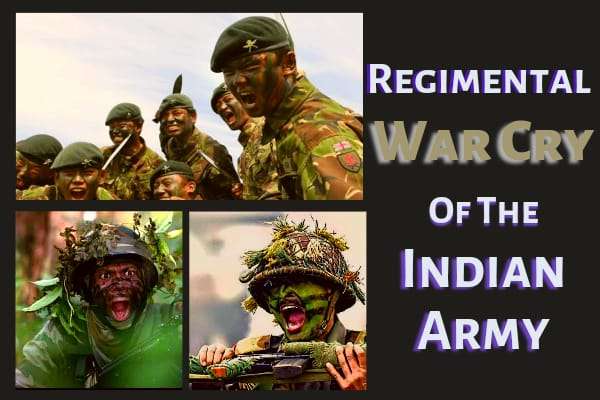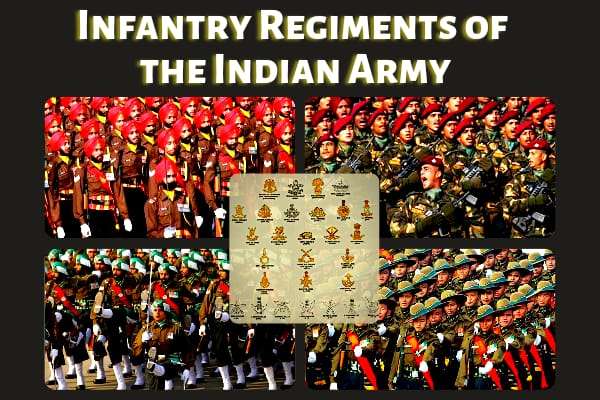In the most inhumane or uninhabitable places – be it the freezing glaciers of Siachen, the thick forests of the North-eastern states, the peaks of the mighty Himalayas, or even the boiling deserts of Rajasthan, an infantry soldier is ready to face any odds and stays vigilant 24*7 to act as our first line of defense. Infantry – popularly known as the ‘Queen of the Battle’, remains highly understated but the most crucial combat arm for armies around the world. The Indian Army consists of a number of regiments and units which has glorious histories. They have even participated in several battles and operations around the world, receiving many battles and theatre honors pre and post-Indian Independence. Every Regiment is different and unique in itself having a magnificent history. So, let’s understand what the Infantry Regiments of the Indian Army are and how they are formed.

Origins of Infantry Regiment in the Indian Army
Before Independence, the Indian Army was part of the British Army. After getting Independence, the Indian Army inherited its predecessor’s organizational structure, which is continued even today. During Initial Days, regiments were formed on regional and caste lines.
During the course of time, several restructuring reforms have been done at every stage, especially after the transfer of power from East India Company to the British Government and from them to the Indian Army.
The British needed to manage and administer India which required the local people to form a force under their command. To do this in a better way, they formed Regiments on the lines of military history, race, and caste, which gave every regiment a distinct individuality by way of dress, tradition, ceremonies, and regimental pride.
The Indian infantry regiment was not only responsible to undertake field operations but also to provide battalions and well-trained personnel to the field formations.
They also recruited soldiers from specific regions across the country and built up associations that remained in place till the retirement of soldiers.
Almost every Indian Army infantry regiment is recruited based on some specific criteria, such as region (The Assam Regiment), caste/community (Jat Regiment), or religion (Sikh Regiment). They continue the tradition of regiments raised under the British Raj, but some have been raised after independence.
Importance of regimentation in the Indian Army
“REGIMENT” word is derived from the Latin word ‘regimen’ which means a law/rule or to lead straight and describes the Regiment’s functions of raising, equipping, and training troops. Every Regiment has its own distinguished insignia, specific uniform and colors, uniform, and accomplishments in the combat zone.
In the Indian Army, there are two kinds of Regiments – battalion-sized units of arms like the Engineers, the Armoured Corps, Artillery, and Signals, or a specific combination of Infantry battalions.
After independence, the Indian Army retained the fundamentals of the regimental system, looking at the strengths and respect it had built over the years.
This includes a sense of pride and honor in the history, Valour, and achievements of each of the regiments, which was created over the decades and in some cases centuries.
It included some famous triumphs and victories on the battleground and traditions and customs which were peculiar to them, which became their identity.
The regimental system also had regional associations which created a social structure. This system has a son of soil effect which strengthened ties amongst the members of the ever-enlarging family.
This feeling instilled a sense of belonging amongst the battalions and within the regiment. It helped nurture the esprit de corps or brotherhood – an instrumental element both during peace and war.
The regimental system also confirmed a sense of continuousness that binds the soldiers into a single large family. It adds to morale and pride, both vital aspects of warfighting.
Thus, this regimental system is the soul of the Indian Army.
History of Caste-based Infantry Regiments
Taking lessons from the 1857 Sepoy mutiny, the Britishers recruited based on the caste and region by diving the people into martial and non-martial races.
The Jonathan Peel Commission was tasked to identify social groups and regions which were loyal to the British Government during the 1857 revolt and recruit loyal soldiers from these social groups and regions. As the mutiny was more active in the Eastern and Southern region of India, they didn’t recruit them in the Army and also changed the recruitment center to Northern India.
This notion was put to rest after Independence. However, their original names and titles of the regiments were retained purely due to the motivational traits, tradition, and history; all fields that improve military efficiency, as almost every task of the infantry is difficult and demanding.
Then it was decided that no more regiments will be raised on a caste basis, as it become the common public to understand the military system.
Only 1 infantry regiment was raised after independence on the basis of ethnicity – i.e. – Naga Regiment. It was raised for a specific purpose with specific arrangements. The lesser-known fact of the Naga Regiment is that a large proportion of soldiers of the Naga Regiments comprise of Kumaonis, Garhwalis, and some tribes of the North East.
Types of structure of the Army Regiments/Units
- In India, there are four types of structure of army regiments/units;
- Single Class,
- Fixed Class,
- Mixed Fixed Class and
- All India All Class
- Single Class: Those Regiments where all units comprise of only a single ethnic class. Examples – Maratha Regiment, Sikh Regiment, Dogra Regiment.
- Fixed Class: Those Regiments where recruitment is restricted to some specific class of people are people. Example – Rajputana Rifles where primarily Jats and Rajputs are recruited, Grenadiers have units with pure sub-units of Jats, Dogras, Rajputs, and Khem Khani Muslims.
- Mixed Fixed Class: These regiments have mixed sub-units. Example – JAK Light Infantry has Muslim, Sikh, and Dogra troops also in mixed sub-units, The Punjab Regiment is an example that comprises Sikhs, Punjabis and Dogras.
- All India All Class: In these regiments, soldiers are recruited from all over India serving in mixed sub-regiments. Example – The Mahar regiments. Apart from Infantry, Armoured Corps, Mechanised Infantry, and Artillery are organized on an All India All Class basis.
Caste Based Regiments that were discontinued before Independence
- The 1st and 3rd (Gaur) Brahman Infantry – It was created in 1903, but was discontinued after World War 1.
- The ‘Chamar Infantry Regiment – It was formed during World War 2 phase, but was disbanded in December 1946.
- The 1st Lingayat battalion – It was initially formed as an Infantry Battalion, which was later converted into an Anti-Tank regiment. This Anti-Tank regiment was disbanded in 1940.

Importance of War Cry of any Regiment
- Every regiment has its own unique Battle/War Cry. Each and every soldier – be it an Officer or soldier roar out when they go into the battleground to face any odd enemy. This War Cry serves as a tool of motivation and solidarity for the troops to fight as one unit for the respect and honor of their regiment, the Army, and the county as a whole.
- Some Examples of War Cry are –
- Jo Bole Sau Nihal Sat Ari Akal – The Sikh and Punjab Regiment,
- Jat Balwan Jai Bhagwan – The Jat Regiment,
- Jai Mahakali Aayo Gorkhali – The Gorkhas Regiment,
- Har Har Mahadev – The Bihar Regiment
Regimental Centre
- Every infantry regiment has a base unit which is called as regimental Centre. Regimental Centre acts as Head Quarter of the regiment, where all the newly recruited soldiers are trained. They learn the basic aspects of the army like firing, drill, and physical fitness to make them ready to face any battle.
- Example – Jat Regimental Centre at Bareilly, Uttar Pradesh, Dogra Regimental Centre at Ayodhya, Uttar Pradesh.
Regimental Insignia
- Regimental Insignia is a distinctive heraldic badge worn by every soldier, which is unique of every regiment. This gives them a distinct identity and differentiates them from other regiments. They are designed in a specific manner that symbolizes the culture, traditions, ethos, and spirit of the regiments.
- These Regimental Insignia are present on their beret or peaked caps.
- The Army Officers who are of the rank of Brigadier and above them, wear embroidered badges with the Ashoka emblem with crossed baton and sword.
Infantry Regiments of the Indian Army
| Regiment | Active From | Regimental Center | War Cry |
| The Madras Regiment | 1758 | Wellington, Tamil Nadu | “Veera Madrassi, Adi Kollu, Adi Kollu” (“Brave Madrassi, Strike and Kill, Strike and Kill!”) |
| The Punjab Regiment | 1761 | Ramgarh Cantonment, Jharkhand | “Jo bole So Nihal, Sat Sri Akal” || “Bol Jawala Ma ki Jai” |
| The Maratha Light Infantry | 1768 | Belgaum, Karnataka | “Bola Shri Chhatrapati Shivaji Maharaj ki Jai” || “Temlai Mata ki Jai” || “Har Har Mahadev” |
| The Rajputana Rifles | 1775 | Delhi Cantonment, Delhi | “Raja Ramachandra ki Jai” |
| The Rajput Regiment | 1778 | Fatehgarh, Uttar Pradesh | “Bol Bajrang Bali Ki Jai” |
| The Grenadiers | 1778 | Jabalpur, Madhya Pradesh | “Sarvada Shaktishali” |
| The Jat Regiment | 1795 | Bareilly, Uttar Pradesh | “Jat Balwan, Jai Bhagwan” |
| The Kumaon Regiment | 1813 | Ranikhet, Uttarakhand | “Kalika Mata ki jai” || “Bajrang Bali ki jai” || “Dada Kishan ki Jai” |
| The Mahar Regiment | 1815 | Saugor, Madhya Pradesh | “Bolo Hindustan ki Jai” |
| The 1 Gorkha Rifles (The Malaun Regiment) | 1815 | Subathu, Himachal Pradesh | “Jai Ma Kali, Aayo Gorkhali” |
| The 3 Gorkha Rifles | 1815 | Varanasi, Uttar Pradesh | “Jai Ma Kali, Aayo Gorkhali” |
| The 9 Gorkha Rifles | 1817 | Varanasi, Uttar Pradesh | “Jai Ma Kali, Aayo Gorkhali” |
| The Jammu & Kashmir Rifles | 1821 | Jabalpur, Madhya Pradesh | “Durga Mata ki Jai” |
| The 8 Gorkha Rifles | 1824 | Shillong, Meghalaya | “Jai Ma Kali, Aayo Gorkhali” |
| The Sikh Regiment | 1846 | Ramgarh Cantonment, Jharkhand | “Jo bole So Nihal, sat sri akal” || “Wahe Guruji Da Khalsa, Wahe Guruji Di Fateh” |
| The 4 Gorkha Rifles | 1857 | Sabathu, Himachal Pradesh | “Jai Ma Kali, Aayo Gorkhali” |
| The 5 Gorkha Rifles (Frontier Force) | 1858 | Shillong, Meghalaya | “Jai Ma Kali, Aayo Gorkhali” |
| The Dogra Regiment | 1877 | Ayodhya, Uttar Pradesh | “Jawala Mata ki Jai” |
| The Garhwal Rifles | 1887 | Lansdowne, Uttarakhand | “Badri Vishal Lal ki Jai” |
| The 11 Gorkha Rifles | 1918-1922; from 1948 | Lucknow, Uttar Pradesh | “Jai Ma Kali, Aayo Gorkhali” |
| Assam Regiment | 1941 | Shillong, Meghalaya | “Rhino Charge” |
| The Bihar Regiment | 1941 | Danapur, Bihar | “Bajrang Bali Ki Jai” || “Har Har Mahadev” |
| The Sikh Light Infantry | 1944 | Fatehgarh, Uttar Pradesh | “Jo bole So Nihal, Sat Sri Akal” |
| The Parachute Regiment | 1945 | Bengaluru, Karnataka | “Balidan Param Dharma” |
| The Jammu and Kashmir Light Infantry | 1947 | Awantipora, Jammu & Kashmir | “Bharat Mata ki Jai” |
| The Ladakh Scouts | 1963 | Leh, Ladakh | “Ki ki so so Lhargyalo” (“Victory to God”) |
| The Naga Regiment | 1970 | Ranikhet, Uttarakhand | “Jai Durga Naga” |
| The Arunachal Scouts | 2010 | Rayang, Pasighat, Arunachal Pradesh | |
| The Sikkim Scouts | 2013 | Lucknow, Uttar Pradesh |
Hope this article would have given you a clear picture of how Infantry Regiments were formed, how they were managed, and the current Infantry regiments of the Indian Army. For any questions/doubts or if you need any further clarification/explanation, do mention it in the comment segment or you can mail directly at [email protected].
Jai Hind.
Also, Read


